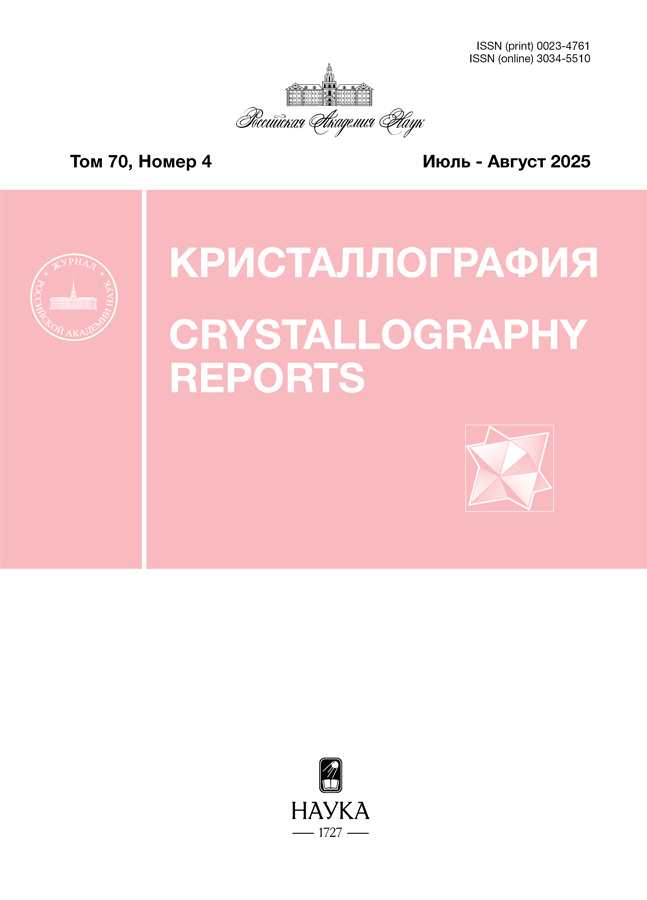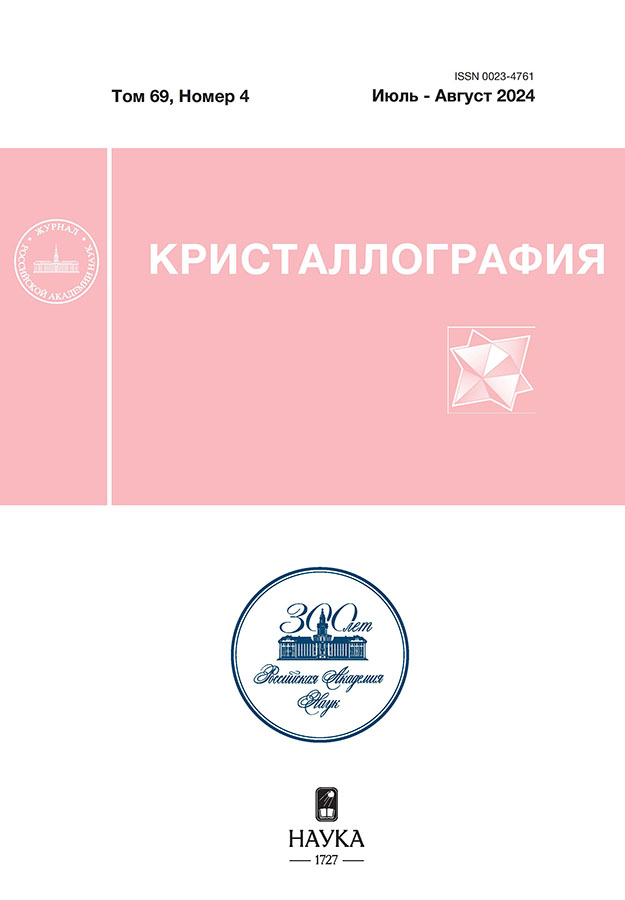Conduction band electronic states of ultrathin furan-phenylene co-oligomer on the surfaces of oxidized silicon and of layer-by-layer grown zinc oxide
- Authors: Komolov А.S.1, Pronin I.A.2, Lazneva Е.F.1, Sobolev V.S.1, Dubov E.A.1, Komolova A.A.1, Zhizhin Е.V.1, Pudikov D.A.1, Pshenichnyuk S.A.3, Becker C.S.4, Kazantsev M.S.4, Akbarova F.D.5, Sharopov U.B.5,6
-
Affiliations:
- St. Petersburg State University
- Penza State University
- Institute of Molecule and Crystal Physics, Ufa Federal Research Centre, Russian Academy of Sciences
- N. N. Vorozhtsov Novosibirsk Institute of Organic Chemistry, Siberian Branch of Russian Academy of Sciences
- Physical-Technical Institute, Uzbekistan Academy of Sciences
- Bukhara State University
- Issue: Vol 69, No 4 (2024)
- Pages: 670-675
- Section: НАНОМАТЕРИАЛЫ, КЕРАМИКА
- URL: https://ter-arkhiv.ru/0023-4761/article/view/673156
- DOI: https://doi.org/10.31857/S0023476124040139
- EDN: https://elibrary.ru/XCDNNL
- ID: 673156
Cite item
Abstract
The paper reports on results of an investigation of the electronic states of the conduction band of ultrathin films of furan-phenylene co-oligomer 1,4-bis(5-phenylfuran-2-yl)benzene (FP5) and the results of an investigation of the interfacial potential barrier upon the formation of these films on the surfaces of (SiO2)n-Si and of layer-by-layer deposited ZnO. Upon deposition of an 8–10 nm thick FP5 film, the total current spectroscopy (TCS) technique was used for investigation within the energy range from 5 eV to 20 eV above EF. FP5 films on the (SiO2)n-Si surface showed a domain structure with a characteristic domain size of the order of 1 micro.m × 1 micro.m and a surface roughness within the domain under 1 nm. In contrast, FP5 on the ZnO surface showed a granular structure with a grain height of 40–50 nm.
Full Text
About the authors
А. S. Komolov
St. Petersburg State University
Author for correspondence.
Email: a.komolov@spbu.ru
Russian Federation, St. Petersburg
I. A. Pronin
Penza State University
Email: a.komolov@spbu.ru
Russian Federation, Penza
Е. F. Lazneva
St. Petersburg State University
Email: a.komolov@spbu.ru
Russian Federation, St. Petersburg
V. S. Sobolev
St. Petersburg State University
Email: a.komolov@spbu.ru
Russian Federation, St. Petersburg
E. A. Dubov
St. Petersburg State University
Email: a.komolov@spbu.ru
Russian Federation, St. Petersburg
A. A. Komolova
St. Petersburg State University
Email: a.komolov@spbu.ru
Russian Federation, St. Petersburg
Е. V. Zhizhin
St. Petersburg State University
Email: a.komolov@spbu.ru
Russian Federation, St. Petersburg
D. A. Pudikov
St. Petersburg State University
Email: a.komolov@spbu.ru
Russian Federation, St. Petersburg
S. A. Pshenichnyuk
Institute of Molecule and Crystal Physics, Ufa Federal Research Centre, Russian Academy of Sciences
Email: a.komolov@spbu.ru
Russian Federation, Ufa
Ch. S. Becker
N. N. Vorozhtsov Novosibirsk Institute of Organic Chemistry, Siberian Branch of Russian Academy of Sciences
Email: a.komolov@spbu.ru
Russian Federation, Novosibirsk
M. S. Kazantsev
N. N. Vorozhtsov Novosibirsk Institute of Organic Chemistry, Siberian Branch of Russian Academy of Sciences
Email: a.komolov@spbu.ru
Russian Federation, Novosibirsk
F. Dj. Akbarova
Physical-Technical Institute, Uzbekistan Academy of Sciences
Email: a.komolov@spbu.ru
Uzbekistan, Tashkent
U. B. Sharopov
Physical-Technical Institute, Uzbekistan Academy of Sciences; Bukhara State University
Email: a.komolov@spbu.ru
Uzbekistan, Tashkent; Bukhara
References
- Varghese M.A., Anjali A., Harshini D. et al. // ACS Appl. Electron. Mater. 2021. V. 3. P. 550. https://doi.org/10.1021/acsaelm.0c00931
- Nenashev G.V., Kryukov R.S., Istomina M.S. et al. // J. Mater. Sci.: Mater. Electron. 2023 V. 34. P. 2114. https://doi.org/10.1007/s10854-023-11566-5
- Алешин А.Н., Щербаков И.П., Трапезникова И.Н. и др. // ФТТ. 2016. Т. 58. С. 1818.
- Sosorev A.Y., Nuraliev M.K., Feldman E.V. et al. // Phys. Chem. Chem. Phys. 2019. V. 21. P. 11578. https://doi.org/10.1039/C9CP00910H
- Koskin I.P., Becker Ch.S., Sonina A.A. et al. // Adv. Funct. Mater. 2021. V. 31. P. 2104638. https://doi.org/10.1002/adfm.202104638
- Mannanov A.A., Kazantsev M.S., Kuimov A.D. et al. // J. Mater. Chem. C. 2019. V. 7. P. 60. https://doi.org/10.1039/C8TC04151B
- Kazantsev M.S., Frantseva E.S., Kudriashova L.G. et al. // RSC Adv. 2016. V. 6. P. 92325. https://doi.org/10.1039/C6RA23160H
- Hill I.G., Schwartz J., Kahn A. // Org. Electron. 2000 V. 1. P. 5. https://doi.org/10.1016/S1566-1199(00)00002-1
- Krzywiecki M., Smykala S., Kurek J. et al. // Phys. Chem. Chem. Phys. 2022. V. 24. P. 11828. https://doi.org/10.1039/D2CP00844K
- Komolov A.S., Akhremtchik S.N., Lazneva E.F. // Spectrochim. Acta. A. 2011. V. 798. P. 708. https://doi.org/10.1016/j.saa.2010.08.042
- Sharopov U.B., Abdusalomov A., Kakhramonov A. et al. // Vacuum. 2023. V. 213. P. 112133. https://doi.org/10.1016/j.vacuum.2023.112133
- Лазарев В.В., Блинов Л.М., Юдин С.Г. и др. // Кристаллография. 2015. Т. 60. C. 314. https://doi.org/10.7868/S0023476115020162
- Frankenstein H., Leng C.Z., Losego M.D. et al. // Org. Electron. 2019. V. 64. P. 37. https://doi.org/10.1016/j.orgel.2018.10.002
- Walter T.N., Lee S., Zhang X. et al. // Appl. Surf. Sci. 2019. V. 480. P. 43. http://doi.org/10.1016/j.apsusc.2019.02.182
- Комолов А.С., Лазнева Э.Ф., Соболев В.С. и др. // Кристаллография. 2024. Т. 69. C. 134. https://doi.org/10.31857/S0023476124010197
- Komolov A.S., Lazneva E.F., Gerasimova N.B. et al. // J. Electron Spectr. Rel. Phenom. 2019. V. 235. P. 40. https://doi.org/10.1016/j.elspec.2019.07.001
- Pshenichnyuk S.A., Asfandiarov N.L., Markova A.V. et al. // J. Chem. Phys. 2023. V. 159. P. 214305. https://doi.org/10.1063/5.0180053
- Pshenichnyuk S.A., Modelli A., Lazneva E.F. et al. // J. Phys. Chem. A. 2016. V. 120. P. 2667. https://doi.org/.1021/acs.jpca.6b02272
- Hwang J., Wan A., Kahn A. // Mater. Sci. Eng. R. 2009. V. 64. P. 1. https://doi.org/10.1016/j.mser.2008.12.001
- Кукушкин С.А., Осипов А.В., Романычев А.И. // ФТТ. 2016. Т. 58. С. 1398.
- Komolov A.S., Moeller P.J., Lazneva E.F. // J. Electron Spec. Rel. Phen. 2003. V. 131–132. P. 67. https://doi.org/10.1016/S0368-2048(03)00104-X
- Bartos I. // Progr. Surf. Sci. 1998. V. 59. P. 197. https://doi.org/10.1016/S0079-6816(98)00046-X
- Komolov A.S., Lazneva E.F., Akhremtchik S.N. // Appl. Surf. Sci. 2010. V. 256. P. 2419. https://doi.org/10.1016/j.apsusc.2009.10.078
- Komolov A.S., Moeller P.J., Aliaev Y.G. et al. // J. Mol. Struct. 2005. V. 744–747. P. 145. https://doi.org/10.1016/j.molstruc.2005.01.047
- Shu A.L., McClain W.E., Schwartz J. et al. // Org. Electron. 2014. V. 15. P. 2360. https://doi.org/10.1016/j.orgel.2014.06.039
- Braun S., Salaneck W., Fahlman M. // Adv. Mater. 2009. V. 21. P. 1450. https://doi.org/10.1002/adma.200802893
Supplementary files















